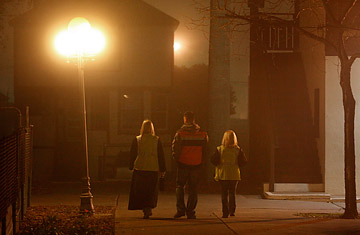
Members of the neighborhood group Kentucky Street Watch Owls monitor an area popular with prostitutes in Vallejo, Calif.
It's Saturday night in Vallejo, Calif., a medium-size town 25 miles (40 km) northeast of San Francisco, and the locals have hit the streets looking for prostitutes — not to do business with them, but to scare them off.
Half a dozen members of a local neighborhood group called the Kentucky Street Watch Owls are out on patrol, walking the streets to discourage prostitutes and their customers from plying their trade in the community. Vallejo lately has become a magnet for the sex trade for one simple reason: the city is flat broke. If Vallejo is any indication, things could get pretty crazy in other cash-strapped cities across the country.
Since Vallejo declared bankruptcy in May 2008, its police force has shrunk by almost 40%. That's led to a steep rise in prostitution, with some girls traveling from as far away as Oregon and Mexico to work the streets of Vallejo. More johns are cruising the city's streets, some drawn by adult websites and chat rooms publicizing the influx of sex workers.
"I leave my house at 7 in the morning and sometimes see girls working on the streets that early," says Kathy Beistel, block captain of the Kentucky Street Watch Owls. "There's no peak time — it's all peak time."
The group members don't confront prostitutes and johns aggressively; rather, they let sex workers know they're being watched by standing near them and occasionally engaging them in conversation. Often, the sight of a group of chatty neighbors wearing fluorescent yellow safety vests is enough to make prostitutes and their customers move along.
Several blocks away, Teresa Miller, a 30-year-old student who has lived in Vallejo most of her life, says the prostitution problem is out of control.
"I've been approached on the street right by my house by johns who thought I was a prostitute," says Miller. "I'll get in their face and yell at them, 'No, I'm not a prostitute. Go home to your wife!' Lately, if I walk around at night I try to wear my boyfriend's clothes and put a hoodie on so I'm not mistaken."
Vallejo had been struggling economically ever since the local naval yard shut down in 1996. But when the housing bubble burst, property taxes crashed and the city was unable to support the salaries and benefits of its public servants, which accounted for nearly 80% of the budget. Since filing for bankruptcy, the city has cut services to the bone. In addition to the shrinking police force, three firehouses were closed. Along with prostitution, property crimes and car break-ins have also been on the rise since the cutbacks.
But hard times are inspiring residents to do the work once left to the government. Vallejo now has more than 200 neighborhood-watch groups, up from only 10 groups in 2009. The Kentucky Street Watch Owls is among the most active. Besides conducting patrols several times a month, the group meets regularly to chat about neighborhood problems and maintains a Facebook page that posts photos of suspicious activity.
Residents are also active in the city-sponsored Prostitution Task Force, which is mulling over a wide range of possible measures such as street-level video cameras and an outreach program for women who want to leave the sex trade. There's even talk of shaming johns by publicizing the names of those arrested and sending so-called Dear John letters to men suspected of trolling for prostitutes.
Some Vallejo residents say they've already seen conditions improve somewhat. And if nothing else, Vallejo's adversity has helped bring the community closer together. "Some good has actually come of this," says Beistel. "I now know almost every neighbor for three blocks around. That's great."
